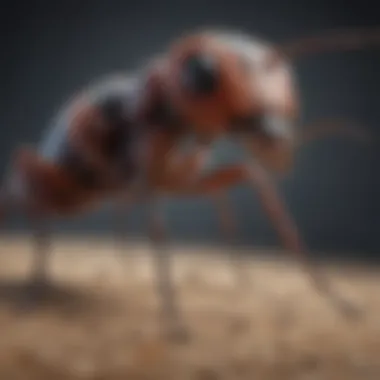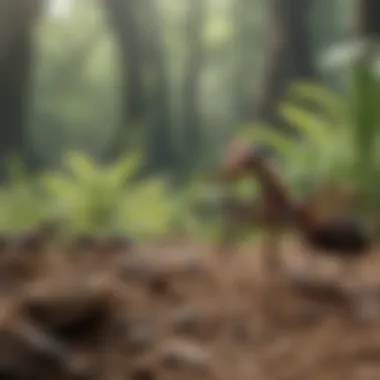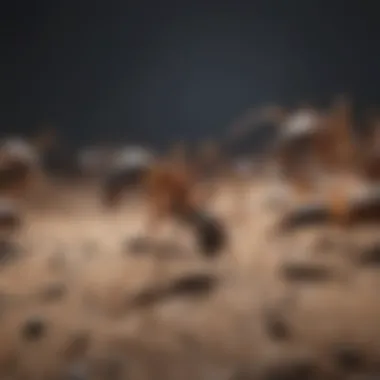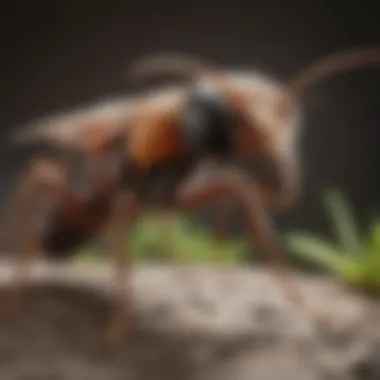Understanding Stinky Ants: Biology, Behavior & Control


Intro
Stinky ants, often overlooked, play a significant role in their ecosystems. Their pungent odor, primarily a defense mechanism, is both fascinating and alarming. This article provides a comprehensive understanding of these insects by breaking down their biology, behavior, and ecological functions. In addition, it explores effective management and control techniques. The information here is valuable for homeowners and anyone interested in maintaining a harmonious household environment.
Understanding Pests
Definition of Pests
Pests are organisms that cause harm to humans, animals, plants, or structures. Insects like stinky ants fit into this category when they invade homes or gardens. They may not only pose a nuisance but can also lead to structural damage or compromised hygiene.
Importance of Pest Identification
Identifying pests accurately is crucial for effective management. Misunderstanding the species can result in ineffective control methods. Stinky ants, for example, can be confused with other ant species. Knowing the specific type can lead to more appropriate solutions, reducing both environmental impact and cost.
Prevention Techniques
Home and Garden Preventative Measures
Preventing stinky ants from invading your home starts with simple steps. Keep food sealed and dispose of waste properly. Regular cleaning of surfaces can deter these pests. In gardens, maintaining healthy plants can create an uninviting environment for ants.
Seasonal Prevention Tips
Seasonal changes can influence ant behavior. In spring and summer, they tend to move indoors looking for food. During these times, check for cracks and openings around the house. Seal these gaps to keep ants outside. In colder months, be mindful of warmth sources that might attract them.
Eco-Friendly Pest Control Solutions
Overview of Sustainable Practices
Sustainable pest control is about managing pests in a way that protects the environment. This includes using methods that do not harm beneficial insects or the local ecosystem. Integrated pest management (IPM) is a common approach, combining biological, cultural, and mechanical tools for effective pest control.
Natural Remedies and Their Effectiveness
Natural remedies can address stinky ant problems effectively. Vinegar, for instance, is often used to disrupt their scent trails. Other options include diatomaceous earth and essential oils, like peppermint oil, which can deter these ants without harming the environment.
"Understanding the biology and behavior of pests is key to effective control."
By employing these strategies, homeowners can manage stinky ant populations while promoting a balanced ecosystem. Through responsible actions, we can coexist with these insects and mitigate their impacts on our personal spaces.
Prelims to Stinky Ants
The study of stinky ants is essential for anyone interested in ecology, pest management, or even the intricate interconnections of our environment. Contrary to their unpleasant odor, these insects play significant roles in their ecosystems. Understanding their biology and behavior allows homeowners and pest control professionals to manage their populations effectively without resorting to harmful chemicals. Knowing why stinky ants emit odors can influence both control methods and public perception.
Definition and Overview
Stinky ants, often referred to by their scientific families, produce a noticeable odor when they feel threatened. This scent is not merely a nuisance; it serves as a defense mechanism to ward off predators. The unique chemistry of their excreta varies among species, which contributes to different scent profiles. The insects can be found in various habitats, ranging from forests to urban areas, making their study relevant across diverse ecosystems.
Significance in the Ecosystem
The ecological impact of stinky ants cannot be overstated.


- Decomposers: They break down organic matter, aiding nutrient cycling in the soil. Their activities help maintain soil health, which is crucial for plant growth.
- Food Source: Stinky ants are prey for several species, including birds and other insects. Their presence supports the food web, ensuring that various ecosystems remain balanced.
- Pest Control: By feeding on aphids and other pests, these ants contribute to natural pest management. This biological control reduces the need for chemical interventions, aligning well with eco-friendly practices.
In summary, stinky ants exemplify the balance of nature's design. Their multifaceted roles highlight the importance of understanding them for both ecological balance and pest control strategies. By observing and analyzing their behaviors and characteristics, homeowners can adjust their approaches, benefiting their living environments.
Identification of Stinky Ant Species
Identifying stinky ant species is crucial for understanding their role within the ecosystem and assessing their potential impact on human spaces. Knowing the specific types of stinky ants assists homeowners in recognizing which species they may encounter, informing appropriate responses in case of an infestation. Additionally, species identification aids in implementing targeted pest control measures that minimize harm to non-target organisms.
Common Species and Their Characteristics
Stinky ants belong to various genera, with some common species including:
- Formica rufa known as the red wood ant, recognized for its social structure.
- Tapinoma sessile, or the odorous house ant, famous for its strong, pungent odor.
- Acanthomyops spp., which includes several types that release a distinct smell when threatened.
Each of these species possesses unique traits that can help in identification. For example, the red wood ant is larger and exhibits a complex nest architecture commonly found in forests, while the odorous house ant is smaller and often found in urban settings, especially in kitchens and pantries.
In addition to these specific species, observing their behavior and habitat can further assist in identifying stinky ants. Their foraging patterns and communal behavior may provide insight into their social dynamics and preferences.
Physical Traits and Distinguishing Features
Stinky ants display a variety of physical characteristics that help in distinguishing them from other ant species. Typically, they range from tiny to medium size, but some can grow larger. Key distinguishing features include:
- Body Color: This can vary significantly, from dark brown to reddish hues.
- Segmented Body Structure: Like many ants, stinky ants possess three main body parts: the head, the thorax, and the abdomen, which in some species is more pronounced.
- Antennae: These are important for their navigation and communication; they tend to be elbowed and segmented.
- Mandibles: Their mandibles can be quite strong, helping them defend against threats.
- Odor: When disturbed, the release of a strong, unpleasant smell is a hallmark trait setting them apart from less pungent species.
Learning to recognize these traits is vital for both homeowners and pest control professionals. A clear understanding facilitates early detection and intervention, which is key to minimizing any potential nuisances caused by these ants.
Chemical Composition and Odor Production
The chemical makeup of stinky ants and the mechanisms through which they produce their notable odors are vital aspects of their biology. Understanding these elements can help demystify their behavioral patterns and ecological roles. This knowledge is particularly relevant for housewives and homeowners aiming to manage pest issues effectively. Recognizing the components involved in odor production grants insight into why these ants release certain smells when threatened, thus contributing to their survival and defense strategies.
Chemical Compounds Involved
Stinky ants primarily produce pungent odors through specific chemical compounds. Among these, the most well-known are formic acid and various alkaloids. Formic acid, both an irritant and a defensive chemical, creates a sharp smell that is easily recognized. Other compounds may vary by species but often include pheromones that serve multiple functions, from marking territory to alerting others of danger.
- Formic Acid: The main component. Released during defense, it can deter predators.
- Alkaloids: These organic compounds can also contribute to smell and may have additional roles in communication.
- Pheromones: Though primarily for communication, some pheromones can also blend in with the smell produced, enhancing their ability to repel threats.
These compounds serve crucial purposes in the ants' ecosystem, from deterring would-be predators to facilitating complex social interactions within colonies.
Mechanisms of Odor Release
The process of odor release in stinky ants is intricate and happens mainly when the animals feel threatened or are disturbed. Upon being handled or threatened, specialized glands in their bodies secrete the chemical compounds. The mechanism includes:
- Defensive Posture: When threatened, ants may first adopt a defensive stance, which prepares their glands for release.
- Gland Activation: Ants possess glands located near their abdomens that are responsible for producing the compounds. Activation occurs rapidly when the ant perceives danger.
- Ejection: The compounds are forcefully ejected, sometimes in a spray form. This mechanism is effective for ensuring that the deterrent reaches nearby threats.
"Stinky ants utilize their odor production as both a defense and a communication tool, showcasing their evolutionary adaptability."
The release of these chemicals is not random. It reflects a well-defined biological purpose that ties into their broader ecological interactions. Understanding this complexity can further aid in pest control strategies, as knowing when and why these ants release odors can help in developing more targeted and effective management practices.
Behavioral Patterns of Stinky Ants


The study of stinky ants' behavior reveals critical insights that contribute significantly to their survival and ecological roles. Understanding these patterns helps in pest control strategies, as knowing when and how these ants behave can inform decisions for managing infestations. Their behavioral responses are closely tied to their environmental interactions, and they reflect adaptations evolved to enhance their chances of survival and reproduction.
Defense Mechanisms
Stinky ants possess remarkable defense mechanisms, primarily relying on the pungent odors they produce. When threatened, these ants can release chemicals that serve both as an alarm signal to their colony and as a deterrent to potential predators. This adaptive behavior is critical for maintaining colony integrity and enhancing survival rates. Chemical compounds, such as formic acid, play a major role in producing these odors. The delivery of this signal is often immediate, showcasing the ant's ability to respond rapidly to threats.
- Alarm pheromones: When danger is detected, stinky ants can emit specific pheromones that alert other ants, assembling them for collective defense.
- Predator deterrence: The foul smell produced can ward off various predators, making an ant less appealing for consumption.
This means that observing the triggering of these defense mechanisms offers clues about their environment. For home and property owners, understanding these patterns can assist in addressing infestations before they become overwhelming. Recognizing warning signs may provide insights into the presence of these ants and the necessity for action.
Foraging Behavior
Foraging in stinky ants is a systematic and organized process. These ants actively search for food, relying on their keen sense of smell to locate and identify resources. They often employ pheromone trails to communicate the location of food sources to other colony members. This collective behavior enhances their efficiency in gathering sustenance.
- Trail-laying behavior: Stinky ants lay down pheromones that lead other ants to food sources. This results in a network of trails that can be observed, particularly when food is abundant.
- Food preferences: Certain species exhibit preferences for sugary substances, while others might target insects or plant materials. Understanding these preferences can aid in determining the best pest control strategies.
This method of foraging showcases the importance of collaboration among colony members. It also emphasizes the relevance of these behaviors in interactions with their environment and other species. For homeowners, recognizing how these ants forage may inform approaches to preventing infestations, especially by managing attracted foods around the home.
"Studying the foraging patterns of stinky ants not only aids in ecological understanding but also enhances pest control measures, aligning human interests with natural processes."
In summary, understanding the behavioral patterns of stinky ants—through their defense mechanisms and foraging behavior—provides valuable insights into their ecological and environmental roles. Moreover, this understanding equips homeowners with practical knowledge to effectively manage interactions with these insects.
The Role of Stinky Ants in the Food Web
Stinky ants play a significant role in the ecosystems they inhabit. Their presence affects various biological and ecological processes, contributing to the balance of life forms within their environments. This section explores how these ants function within the food web, detailing their relationships as both predators and prey.
Predators and Prey Dynamics
In many ecosystems, stinky ants serve as both predators and prey. As predators, they feed on various small insects, larvae, and other arthropods. Their hunting skills help regulate the populations of these organisms. For instance, species like the Formica and Camponotus have been observed capturing other insects, particularly those that are harmful to plants or crops.
On the flip side, stinky ants themselves become prey for larger species. Birds, amphibians, and even some mammals include these ants in their diets. This dynamic contributes to the overall stability of the ecosystem. By effectively controlling pest populations as predators while also being a food source for larger animals, stinky ants maintain a vital equilibrium.
"The balance between various species is crucial for a healthy ecosystem, showcasing the intertwined roles of predators and prey."
Interaction with Other Insects
Stinky ants not only interact with their prey but also engage with other insect species in critical ways. Their unique odor plays a role in their interactions. Other insects often recognize the presence of stinky ants through their scent, which can either instigate avoidance or trigger defensive responses.
Additionally, these ants have symbiotic relationships with certain species, such as aphids. Stinky ants protect aphids from predators in exchange for honeydew, a sugary substance produced by the aphids. This relationship exemplifies the interconnectedness of food webs, illustrating how actions of one species can directly benefit another.
Furthermore, stinky ants participate in competitive behaviors, often vying for resources or territory with other ant species and insects. They engage in aggressive encounters to defend their nests. These interactions are essential as they influence population dynamics and resource availability in their shared environments.
Cultural Perceptions of Stinky Ants
Cultural perceptions surrounding stinky ants can significantly shape human interactions with these insects. Understanding these perceptions is crucial for making informed decisions about pest control and ecological preservation. Stinky ants have been a part of folklore and tradition, often viewed through various lenses that reflect societal attitudes toward insects in general. This examination reveals how beliefs and stories influence perceptions while highlighting the significance of stinky ants in daily life.
Stinky Ants in Folklore and Tradition
Throughout history, stinky ants have appeared in folklore and traditions across cultures. In some regions, they are regarded with superstition, often viewed as omens or symbols of good fortune. For example, certain cultures might believe that if stinky ants invade a home, it signifies a forthcoming change or transformation. In contrast, others may associate their presence with bad luck or pestilence, prompting residents to act quickly to eliminate them.


These cultural narratives often reflect deeper values about nature and humanity's relationship with it. Stories about stinky ants can serve as allegories, comparing their survival instincts to human resilience. This allows communities to appreciate the ant's ecological role while simultaneously acknowledging its nuisance in populated areas.
Modern Attitudes Towards Stinky Ants
In contemporary society, modern attitudes toward stinky ants are generally mixed. Many individuals view these insects primarily through a lens of irritation and annoyance, particularly when they invade personal spaces. As urban areas expand, stinky ants increasingly find their way into homes, leading to a rising demand for pest control solutions. Thus, the conversation about stinky ants often focuses on their negative implications rather than their ecological contributions.
However, there is also a growing awareness of and interest in sustainable pest control methods. Many homeowners are recognizing the importance of maintaining a balanced ecosystem. This shift in attitude emphasizes coexistence over extermination. Consequently, educational initiatives are emerging to inform the public about the ecological benefits of stinky ants, such as soil aeration and pest regulation.
"Understanding stinky ants' role in the ecosystem can lead to more informed decisions regarding pest control, promoting harmony between humans and nature."
In summary, cultural perceptions of stinky ants encapsulate a range of attitudes from reverence to disdain. By examining their presence in folklore and modern society, we can better appreciate not only the complexity of these insects but also the multifaceted relationship we share with the natural world.
Implications for Pest Control
The consideration of stinky ants in pest control strategies is crucial due to their unique behaviors and ecological significance. Unlike other pests, these insects possess a potent odor that serves multiple functions, both for their survival and interactions with other species. Understanding their habits can lead to more effective management practices, ensuring that solutions respect ecological balance.
When Stinky Ants Become a Nuisance
Stinky ants can transform from benign creatures to troublesome pests when they invade homes or gardens. The pungent scent they emit is often a defense mechanism. When these ants feel threatened or disturbed, they release chemicals that not only alert other ants to danger but can also be unpleasant for humans. Common situations leading to nuisance include:
- Food Sources: Stinky ants are often drawn to food, particularly sugary substances, making kitchens a common target.
- Shelter Seeking: They may invade homes seeking shelter, especially during fluctuating weather conditions.
When infestations occur, they can disrupt daily activities. Prompt identification and intervention become essential for maintaining a comfortable living space. The presence of stinky ants can indicate underlying issues such as moisture problems or food sources that require attention.
Eco-Friendly Control Methods
Addressing stinky ant issues should not involve harmful chemicals. Eco-friendly solutions are effective, sustainable, and more aligned with modern pest management philosophies. Some notable methods include:
- Natural Repellents: Ingredients like vinegar, citrus, or essential oils can deter stinky ants without causing harm to the environment.
- Boric Acid: When used judiciously, boric acid serves as a less toxic bait that effectively targets ant colonies without posing significant risks to other wildlife.
- Exclusion Practices: Sealing entry points, cleaning up food residues, and maintaining a tidy environment can help prevent ants from entering homes.
By implementing these methods, homeowners can control stinky ant populations while preserving the ecosystem. It is vital to remain vigilant and monitor for signs of return, ensuring that the initial effort has lasting effects.
"Integrated Pest Management (IPM) emphasizes understanding pest behavior and ecology rather than relying solely on chemical solutions."
The need for a balanced approach to pest control not only addresses immediate issues but promotes long-term environmental health.
Closure
Understanding stinky ants is crucial not just for pest management, but for appreciating their ecological roles. They contribute significantly to soil aeration and nutrient cycling. These ants often act as prey for various wildlife, forming essential parts of food webs. Ignoring their importance can lead to an oversight of ecological dynamics in local environments.
Additionally, the implications for pest control cannot be overstated. By recognizing how to manage their populations effectively, homeowners can mitigate potential nuisance while fostering sustainable practices. This is beneficial, considering the increasing preference for eco-friendly pest management solutions.
Advancing our knowledge about stinky ants opens pathways for future exploration. Research can uncover new methods of controlling these species and enhancing our general understanding of their biology and behavior.
"A well-informed approach to pest management not only protects our living spaces but also nurtures the ecosystem around us."
Summary of Key Points
- Biology and Behavior: Stinky ants produce an odor as a defense mechanism. This trait can be essential in their survival and ecological balance.
- Ecological Roles: They help in decomposition and nutrient recycling.
- Pest Management: Understanding their behavior can lead to better control methods.
- Cultural Perspectives: Perceptions of these ants vary widely across cultures, impacting how they are treated in different regions.
- Future Research: There are numerous directions for future studies, particularly regarding sustainable pest control methods.
Future Research Directions
Future research on stinky ants can focus on several areas:
- Impact on Ecosystems: Understanding their specific role within various ecosystems can guide preservation efforts.
- Pest Control Innovations: Development of novel, eco-friendly control methods that are effective against stinky ants specifically.
- Behavioral Studies: Detailed studies on their social structures and communication can reveal more about their survival strategies.
- Chemical Composition Analysis: Investigating the specific chemical compounds used in their odor production can lead to insights that benefit pest management practices.
By addressing these aspects, we can gain deeper insights into both the practical and ecological significance of stinky ants.



